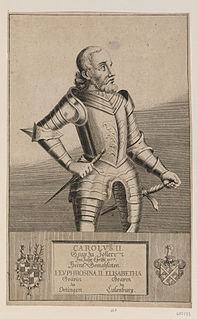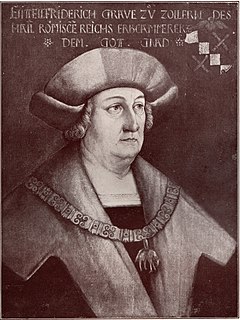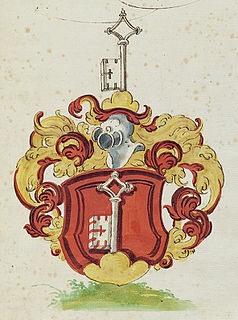
The House of Hohenzollern is a German royal dynasty whose members were variously princes, electors, kings and emperors of Hohenzollern, Brandenburg, Prussia, the German Empire (respectively), and Romania. The family came from the area around the town of Hechingen in Swabia during the late 11th century and took their name from Hohenzollern Castle. The first ancestors of the Hohenzollerns were mentioned in 1061.

Meinhard II, a member of the House of Gorizia (Meinhardiner), ruled the County of Gorizia and the County of Tyrol together with his younger brother Albert from 1258. In 1271 they divided their heritage and Meinhard became sole ruler of Tyrol. In 1286 he was enfeoffed with the Duchy of Carinthia and the adjacent March of Carniola.

Bernard I of Baden was Margrave of the Margraviate of Baden from 1391 to 1431.

Sigmaringen Castle was the princely castle and seat of government for the Princes of Hohenzollern-Sigmaringen. Situated in the Swabian Alb region of Baden-Württemberg, Germany, this castle dominates the skyline of the town of Sigmaringen. The castle was rebuilt following a fire in 1893, and only the towers of the earlier medieval fortress remain. Schloss Sigmaringen was a family estate of the Swabian Hohenzollern family, a cadet branch of the Hohenzollern family, from which the German Emperors and kings of Prussia came. During the closing months of World War II, Schloss Sigmaringen was briefly the seat of the Vichy French Government after France was liberated by the Allies. The castle and museums may be visited throughout the year, but only on guided tours. It is still owned by the Hohenzollern-Sigmaringen family, although they no longer reside there.

Charles II, Count of Hohenzollern-Sigmaringen(German: Karl II, Graf von Hohenzollern-Sigmaringen) became Count of Hohenzollern-Sigmaringen in 1576 and remained so until his death. He was the fifth but second surviving son of Charles I, Count of Hohenzollern, and Anna, daughter of Ernest, Margrave of Baden-Durlach.

Eberhard I was Count of Württemberg from 1279 until his death. He was nicknamed 'der Erlauchte' or the Illustrious Highness.

Burkhard I, Lord of the House of Hohenzollern is considered the first well-documented ancestor of the Hohenzollern dynasty. Because of his name, it has been attempted to link the Hohenzollern family's descent to the medieval Burchardings family, but without success. His father may have been Friedrich, a count in the Sülichgau area. His mother may have been Irmentrud, the daughter of Count Burkhard of Nellenburg.

Frederick I, Count of Zollern, was often cited as a powerful Swabian Count and supporter of the imperial party of Henry V, Holy Roman Emperor.
Johann Georg of Hohenzollern-Hechingen was the first Prince of Hohenzollern-Hechingen.

Count Eitel Friedrich IV of Hohenzollern was the founder and first Count of the line Hohenzollern-Hechingen as Eitel Friedrich I.
Friedrich V of Zollern nicknamed, the Illustrious was a Count of Zollern.
Friedrich VI, Count of Zollern, also known as Friedrich the Knight, or Friedrich the Elder, was a Count of Hohenzollern

Eitel Friedrich II, Count of Hohenzollern was a count of Hohenzollern and belonged to the Swabian line of the House of Hohenzollern. He was the first president of the Reichskammergericht. As a close friend of the Archduke and later Emperor Maximilian I, he gained great influence in the imperial politics. He managed to consolidate and expand his own territory.
Friedrich VIII, Count of Zollern, nicknamed Easter Sunday was a Count of Hohenzollern.
Meinrad II Charles Anthony of Hohenzollern-Sigmaringen was Prince of Hohenzollern-Sigmaringen from 1689 until his death.
Friedrich IX, Count of Hohenzollern, nicknamed "Fredrick the Old" or "the Black Count", was a German nobleman. He was the ruling count of Hohenzollern from 1339 until his death.
Friedrich XI, Count of Hohenzollern, nicknamed Friedrich the Elder was a German nobleman. He was a member of the House of Hohenzollern and a ruling Count of Hohenzollern-Hechingen.

The House of Rapperswil respectively Counts of Rapperswil ruled the upper Zürichsee and Seedamm region around Rapperswil and parts of, as of today, Swiss cantons of St. Gallen, Glarus, Zürich and Graubünden when their influence was most extensive around the 1200s until the 1290s. They acted also as Vogt of the most influential Einsiedeln Abbey in the 12th and 13th century, and at least three abbots of Einsiedeln were members of Rapperswil family.
Albrecht II of Hohenberg-Rotenburg was Count of Hohenberg and Haigerloch and imperial governor of Lower Swabia. He was a member of the house of Zollern-Hohenberg, a branch of the Swabian House of Hohenzollern which split off in the 12th century. Two stanzas in the Codex Manesse are attributed to him under the name of Albrecht von Haigerloch.

Schlüsselberg was a Franconian aristocratic family which was a member of the high nobility. Until it died out in 1347, the family was able to establish itself firmly in the region of Franconian Switzerland and turned out to be unwelcome competition for the bishops of Bamberg. The Schlüsselbergs founded inter alia the town of a number of Schlüsselfeld in 1336 as well as Schlüsselau Abbey.











